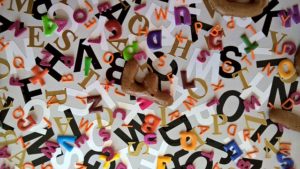
Looking to add some fun to your writing life? You may enjoy this playful exercise of combining words that don’t really go together, then making sense of them to start a story or poem. It’s a type of puzzle based on a fun task I experienced in a poetry workshop years ago in Tampa, Florida, in a program called “The Writer’s Voice.” It helped us warm up our creative juices and generate new ideas—sort of a wordsmith arts and crafts time.
- Take a page of lined notebook paper and number the first ten lines down the page.
- Divide the page lengthwise into three columns by drawing lines to divide them.
- In the first column, write a list of ten nouns, one noun per line, jotting down whatever pops into your mind, i.e. dog, eggs, book, etc.
- In the second column, do the same with ten random adjectives, i.e. lavender, warm, deranged, etc.
- In the third column, list ten verbs, i.e. memorizes, screams, steals, etc.
Result: You have three columns on a sheet of lined paper; each column has ten words. You could also cut the columns apart if you want to make ways to rearrange the words later.
Picking and choosing
Now’s the fun part, sort of gluing phrases together. Read aloud the words on the top lines of each column. My example words would yield this rough, nonsensical sentence: Lavender dog memorizes. Of course! We’ve all heard that before, right?
Making sense of nonsense
Now what? Options are endless. You could throw out that lavender dog silliness or try to work with it. Let’s work and see what happens. I decided to begin a fairytale.
Once upon a time, a little princess had a stuffed animal, a lavender silk dog with dark button eyes that, whenever she held him close, looked as though he were memorizing her face.
Or trash that and read the next line down. In my example, you’d get: Warm eggs scream. Make a sentence with it: “Warm eggs scream, ‘Gobble me up!’” Have some fun with that. Or not.
Continue on down the list. Or, to make new three-word starters, you could a draw line from a random adjective in the first column to a noun farther down the page, then back up to a verb near the top of its column.
Or make entirely new lists of words. Keep some of them. Toss some out. Jumble the lists around, swap out words to come up with whatever phrases you like.
Try using them for fiction, poetry, or a travel story. The point is to spark your imagination, enjoy the sound of language, and create something outside-the-box that most likely has never before existed.

Shutta Crum
I often do a similar exercise with kids. Only I write examples of Who, What, When, Where on tiny slips of papers (each to its own box), and kids pull out one from each box. Then I tell them the story is often the How and Why. Teachers can keep these boxes going all year with kids adding or taking from them throughout the year. And it works for a group exercise. We once pulled : the school principal, wrestling an alligator, at midnight in a cafeteria and did a rollicking group story–all the kids giggling.
Thanks for this reminder of fun ways to get kick-started!
Shutta